As the thinking goes, if it’s good for the up, it’s bad for the down and the holy grail of every backcountry boot made is to find the right balance of each with the widest span possible. Inevitably a compromise is made in one direction or the other, but Dynafit’s Mercury (or Vulcan if you insist) has arguably the widest range available in an alpine boot.
Touring ROM
Where’s the beef?
In combat conditions, stiff boots are your friend — in powder they limit the range of sensations. While the normal configuration is stiff enough with the Mercury, ridiculously stiff with the Vulcan, both can be moderated to allow for a progressive flex by removing the shell tongue. In either case, the reduction in flex resistance will be a welcome relief in soft snow conditions, some of us might even say, all conditions. 😉
That rigidity derives from using a Grilamid lower shell which is 5% stiffer than Pebax, yet lighter. Combined with skeletal ribs for strength the shell can shed more material, yielding a boot weighing les than 3½ pounds per foot (1.51 kg). Yet it has the ability to drive your edges with solid bite in the throat of a couloir loaded with hard, no-fall zone snow. While stiff, that stiffness is not a progressive sensation, but a step function that provides max resistance from the get go. The more mass you have to drive with, the more the cuff will yield, but it ain’t easy. If you remove the tongue, some of the progressive feel of a classic alpine boot with an overlap tongue returns.The main difference between the Mercury and Vulcan is the material in the cuff. For the Mercury, fiberglass reinforces a Grilamid cuff which, as I keep saying, is plenty stiff enough. For those who prefer ridiculously stiff, the Vulcan uses a carbon fiber reinforced Grilamid cuff. Oofff! Better for you perhaps, but not this kid. I skied a pair for a day and ended up taking the tongue out to soften the Vulcan’s up to a more acceptable level and they still felt stiff.
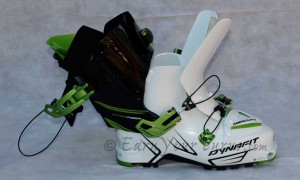
Without a doubt, the TLT cuff will not hinder mobility for touring. The liner will, but not the cuff.
Even if you don’t want to soften the flex of the boot for downhill, on a long climb it may be worth it to put the tongues in your pack, further improving ankle flexibility for more efficient climbing.
Them Details
Dynafit’s TLT5 series boots all come with some pretty nice finishing details. The power buckle on the cuff allowing race caliber touring motion is reason enough to consider these boots. But there’s more to these boots than just that. Consider the buckles, which are micro adjustable, and lock into position on the ladder so you can flip the buckle open without it flopping around and having to reposition it.
The Fit
Dynafit did a good job of working with Intution to come up with a liner that can accommodate a descent range of foot volumes without compromising warmth or performance. I’ve seen D width feet smile with the feel of a Mercury after heat molding, just like some B sized feet do without.
There are multiple densities of foam, to enchance the driving power from your lower leg, and comfort of your toes. A wedge of softer foam is cut into the Achilles zone, to allow for easy rear flexibility so the liner doesn’t steal any motion that the cuff hasn’t denied.
Plus there are other details you want, like a rubber sole for walking around camp, and laces for the same. The upper tongue has a patch of reinforcement, again for more power transfer.Bottom Line
It’s an old adage, but as they say, if the shoe fits, wear it. If these boots fit your feet, except for the fact they don’t tele for squat, I don’t think you’ll be dissatisfied with their performance, in or out of bounds, up or downhill. If you insist on super stiff, try the Vulcans. If you’re still a charger but don’t need that much brawn, stick your feet in the Mercury.
Dynafit
Mercury
MSRP: $800
Weight/boot (mondo 26.5): 3 lbs., 5¼ oz. (1510 g)
Size range: 22.5 — 31.5 (mondo)
Vulcan
MSRP: $999
Weight/boot: (mondo 26.5)
Size range: 22.5 — 31.5 (mondo)
© 2013

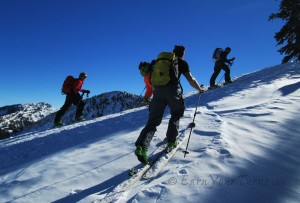
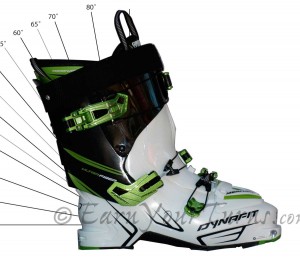
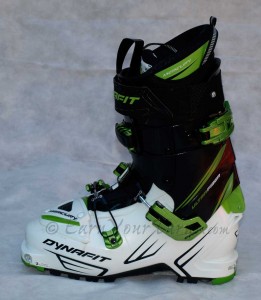
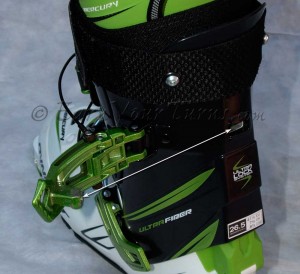
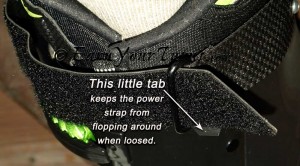
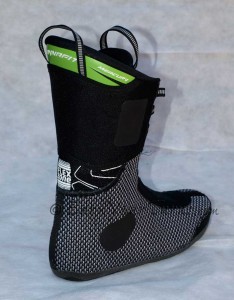
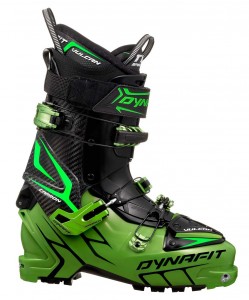
2 comments
1 ping
I love my Vulcans although I wish they were even stiffer for my style of skiing. As a member of the US ski teams World Cup downhill team I demand a lot from my gear and I am used to stiff race boots. When looking for a touring boot the Vulcan is the closest thing to an alpine race boot out there. It’s super comfy and light for the way up and I can still ski aggressively and how I am accustomed to on the way down. On most other touring boots for me I have to ski conservatively on the way down. Most touring boots in the past limited my skiing on the way down, and the Vulcan is still not perfect on the way down, but I can push on the boot and feel some of the same feelings that i love from an alpine boot. Definently a good choice for the hard charging skier who wants to earn their turns.
Travis Ganong
You sure those are Intuitions in the Dynafit boots?
[…] of movement but demand a high level of downhill performance, stop right here and check out the Mercury or Vulcan. However, if you recognize that long tours require a compromise somewhere and you’re game to […]